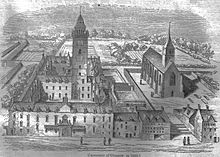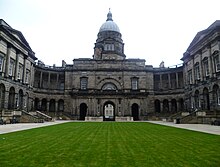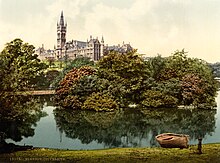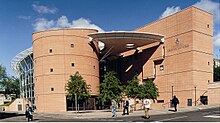History of universities in Scotland

The history of universities in Scotland includes the development of all universities and university colleges in Scotland, between their foundation between the fifteenth century and the present day. Until the fifteenth century, those Scots who wished to attend university had to travel to England, or to the Continent. This situation was transformed by the founding of St John's College, St Andrews in 1418 by Henry Wardlaw, bishop of St. Andrews. St Salvator's College was added to St. Andrews in 1450. The other great bishoprics followed, with the University of Glasgow being founded in 1451 and King's College, Aberdeen in 1495. Initially, these institutions were designed for the training of clerics, but they would increasingly be used by laymen. International contacts helped integrate Scotland into a wider European scholarly world and would be one of the most important ways in which the new ideas of humanism were brought into Scottish intellectual life in the sixteenth century.
In the eighteenth century the universities went from being small and parochial institutions, largely for the training of clergy and lawyers, to major intellectual centres at the forefront of Scottish identity and life, seen as fundamental to democratic principles and the opportunity for social advancement for the talented. Chairs of medicine were founded at all the university towns. By the 1740s
At the beginning of the nineteenth century, Scotland's five university colleges had no entrance exam, students typically entered at ages of 15 or 16, attended for as little as two years, chose which lectures to attend and left without qualifications. The curriculum was dominated by divinity and the law and there was a concerted attempt to modernise the curriculum, particularly by introducing degrees in the physical sciences and the need to reform the system to meet the needs of the emerging middle classes and the professions. The result of these reforms was a revitalisation of the Scottish university system, which expanded to 6,254 students by the end of the century and produced leading figures in both the arts and sciences. In the first half of the twentieth century Scottish universities fell behind those in England and Europe in terms of participation and investment. After the
History
Middle Ages
Background

From the end of the eleventh century, universities had been founded across Europe, developing as semi-autonomous centres of learning, often teaching theology, mathematics, law and medicine.
Among these travelling scholars, the most important intellectual figure was
First Scottish universities

This situation was transformed by the founding of St John's College, St Andrews in 1418. Henry Wardlaw, bishop of St. Andrews, petitioned the anti-Pope Benedict XIII during the later stages of the Great Western Schism, when Scotland was one of his few remaining supporters. Wardlaw argued that Scottish scholars in other universities were being persecuted for their loyalty to the anti-Pope.[5] St Salvator's College was added to St. Andrews in 1450. The other great bishoprics followed, with the University of Glasgow being founded in 1451 and King's College, Aberdeen in 1495. Both were also papal foundations, by Nicholas V and Alexander VI respectively.[6] St. Andrews was deliberately modelled on Paris, and although Glasgow adopted the statues of the University of Bologna, there, like Aberdeen, there was an increasing Parisian influence, partly because all its early regents had been educated in Paris.[7] Initially, these institutions were designed for the training of clerics, but they would increasingly be used by laymen who began to challenge the clerical monopoly of administrative posts in government and law.[2] They provided only basic degrees. Those wanting to study for the more advanced degrees that were common amongst European scholars still needed to go to universities in other countries. As a result, Scottish scholars continued to visit the Continent and returned to English universities after they reopened to Scots in the late fifteenth century.[2]
By the fifteenth century, beginning in northern Italy, universities had become strongly influenced by
Early modern era
Renaissance

The
Reformation
In the mid-sixteenth century, Scotland underwent a
Seventeenth century

King James VI's major contribution to the universities was to combat militant
The five Scottish university colleges recovered from the disruption of the civil war years and Restoration with a lecture-based curriculum that was able to embrace economics and science, offering a high-quality liberal education to the sons of the nobility and gentry.[24] All saw the establishment or re-establishment of chairs of mathematics. The first was at Marshall College in 1613. A university chair was added at St. Andrews in 1668, at Edinburgh in 1674 and at Glasgow in 1691. The chair at Glasgow was first taken by the polymath George Sinclair, who had been deposed from his position in philosophy for his Presbyterianism in 1666, but was able to return after the Glorious Revolution marked a move against episcopalianism.[6] A further chair would be added at King's College Aberdeen in 1703.[25] Astronomy was facilitated by the building of observatories at St. Andrews (c. 1677) and at King's College (1675) and Marischal College (1694) in Aberdeen. Robert Sibbald was appointed as the first Professor of Medicine at Edinburgh and he co-founded the Royal College of Physicians of Edinburgh in 1681.[26] These developments helped the universities to become major centres of medical education and would put Scotland at the forefront of Enlightenment thinking.[24]
Modern era
Eighteenth century

In the eighteenth century the universities went from being small and parochial institutions, largely for the training of clergy and lawyers, to major intellectual centres at the forefront of Scottish identity and life, seen as fundamental to democratic principles and the opportunity for social advancement for the talented.[27] Chairs of medicine were founded at Marsichial College (1700), Glasgow (1713), St. Andrews (1722) and a chair of chemistry and medicine at Edinburgh (1713). It was Edinburgh's medical school, founded in 1732, that came to dominate. By the 1740s it had displaced Leiden as the major centre of medicine in Europe and was a leading centre in the Atlantic world.[28] The universities still had their difficulties. The economic down turn in the mid-century forced the closure of St Leonard's College in St Andrews, whose properties and staff were merged into St Salvator's College to form the United College of St Salvator and St Leonard.[29]
Access to Scottish universities was probably more socially open than in contemporary England, Germany or France. Attendance was less expensive and the student body more representative of society as a whole.
Many of the key figures of the Scottish Enlightenment were university professors, who developed their ideas in university lectures.
Hume became a major figure in the
Nineteenth century

At the beginning of the nineteenth century, Scotland's five university colleges had about 3,000 students between them.
The curriculum and system of graduation were reformed. Entrance examinations that were equivalent to the School Leaving Certificate were introduced and average ages of entry rose to 17 or 18. Standard patterns of graduation in the arts curriculum offered three-year ordinary and four-year honours degrees.

The University of St Andrews was at a low point in its fortunes in the early part of the century. It was restructured by commissioners appointed under the 1858 act and began a revival.[39] It pioneered the admission of women to Scottish universities, creating the Lady Literate in Arts (LLA) in 1882, which proved highly popular. From 1892 Scottish universities could all admit and graduate women, with St Andrews the first to do so, and the numbers of women at Scottish universities steadily increased from this point until the early twentieth century.[40] A new college of St Andrews was opened in the thriving burgh of Dundee in 1883, allowing the university to teach sciences and open a medical school.[27] The University of Glasgow became a leader in British higher education by providing the educational needs of youth from the urban and commercial classes.[41] It moved from the city centre to a new set of grand neo-Gothic buildings, paid for largely by public subscription, at Gilmorehill in 1870.[42] The two colleges at Aberdeen were considered too small to be viable and they were restructured as the University of Aberdeen in 1860. Marischal College was rebuilt in the Gothic style from 1900.[39] Unlike the other Medieval and ecclesiastical foundations, because the University of Edinburgh was a civic college it was relatively poor. In 1858 it was taken out of the care of the city and established on a similar basis to the other ancient universities.[39]

The result of these reforms was a revitalisation of the Scottish university system, which expanded to 6,254 students by the end of the century
At Edinburgh, major figures included
Twentieth century to the present

From 1901 large numbers of students received bursaries from the Carnegie Trust.[27] By 1913 there were 7,776 students in Scottish universities. Of these 1,751 (23 per cent) were women. By the mid-1920s it had risen to a third. It then fell to 25–7 per cent in the 1930s as opportunities in school teaching, virtually the only careers outlet for female graduates in arts and sciences, decreased. No woman was appointed to a Scottish professorship until after 1945.[27] The fall in numbers was most acute among women students, but it was part of a general trend. In the first half of the twentieth century Scottish universities fell behind those in England and Europe in terms of participation and investment. The decline of traditional industries between the wars undermined recruitment to subjects in which Scotland had been traditionally strong, such as science and engineering. English universities increased the numbers of students registered between 1924 and 1927 by 19 per cent, but in Scotland the number of full-time students fell from 10,400 in 1924 to 9,900 in 1937. In the same period, while expenditure in English universities rose by 90 per cent, in Scotland the increase was less than a third of that figure.[47]
Before the First World War relationships between male and female students tended to be very formal, but in the inter-war years there was an increase in social activities, such as dance halls, cinemas, cafes and public houses. From the 1920s much drunken and high spirited activity was diverted into the annual charity gala or rag. Male centred activities included the Student's Union, Rugby Club and Officers' Training Corps. Women had their own unions and athletics clubs. Universities remained largely non-residential, although a few women's halls of residence were created, most not owned by the universities.[27]

After the
After devolution, in 1999 the new
Notes
- ISBN 0415019230, pp. 241–3.
- ^ ISBN 0-333-56761-7, pp. 124–5.
- ^ ISBN 0-7486-0276-3, pp. 68–72.
- ISBN 0-333-56761-7, p. 119.
- ISBN 9004162771, p. 119.
- ^ ISBN 0-19-211696-7, pp. 610–12.
- ISBN 0748616284, p. 34.
- ISBN 0521541131, pp. 452–9.
- ^ ISBN 0-7486-0276-3, pp. 183–4.
- ^ ISBN 0-19-162433-0, pp. 196–7.
- ISBN 038920921X, p. 23.
- ISBN 0748614559, pp. 340–1.
- ISBN 0748614559, p. 55.
- ISBN 0748614559, p. 187.
- ISBN 0748602763, pp. 102–4.
- ISBN 90-04-10097-0, p. 280.
- ^ "The Origin Of Universities". The University of Texas at Austin. Archived from the original on 20 February 2009. Retrieved 15 November 2012.
- ^ "Charter by King James VI". The University of Edinburgh. Retrieved 11 August 2021.
- ^ Grant, Alexander (1884). The Story of the University of Edinburgh During Its First Three Hundred Years. London: Longmans, Green & Co. Retrieved 14 August 2021.
- ISBN 0748602763, p. 185.
- ^ ISBN 1862321140, p. 332.
- ISBN 0140136495, pp. 227–8.
- ISBN 1-4464-7563-8, p. 262.
- ^ ISBN 0-7486-1625-X, pp. 219–28.
- ISBN 0521003237, p. 99.
- ISBN 0-19-162433-0, p. 373.
- ^ ISBN 0-19-211696-7, pp. 612–14.
- ISBN 0521003237, p. 100.
- ^ "Meadieval university" (PDF). Archived from the original (PDF) on 22 July 2013. Retrieved 3 January 2013.
- ISBN 0-521-89088-8, p. 245.
- ISBN 0-609-80999-7.
- ^ a b "The Scottish enlightenment and the challenges for Europe in the 21st century; climate change and energy", The New Yorker, 11 October 2004, archived from the original on 6 June 2011.
- ISBN 0807861138, p. 282.
- ^ M. Magnusson (10 November 2003), "Review of James Buchan, Capital of the Mind: how Edinburgh Changed the World", New Statesman, archived from the original on 6 June 2011.
- ^ A. Swingewood, "Origins of Sociology: the Case of the Scottish Enlightenment", The British Journal of Sociology, vol. 21, no. 2 (June 1970), pp. 164–80 in JSTOR.
- ISBN 0-415-06164-4.
- ISBN 0-7382-0692-X, pp. 117–43.
- ^ ISBN 0-7486-1625-X, p. 224.
- ^ ISBN 0748601023, pp. 147–50.
- ISBN 1-86094-986-X, p. 264.
- ^ P. L. Robertson, "The Development of an Urban University: Glasgow, 1860–1914", History of Education Quarterly, Winter 1990, vol. 30 (1), pp. 47–78.
- ISBN 0719036925, p. 249.
- ISBN 0748601023, p. 151.
- ISBN 0195112296, p. 386.
- ^ J. Browne, "A science of empire: British biogeography before Darwin", Revue d'histoire des Sciences, vol. 45 (1992), p. 457.
- ISBN 0748601023, p. 152-4.
- ISBN 0-7486-0999-7, pp. 78–9.
- ISBN 0-19-211696-7, pp. 614–5.
- ISBN 0-7486-1625-X, pp. 664–5.
- ^ C. G. Brown, "Chapter 1- Charting Everyday Experience", in L. Abrams and C. G. Brown, eds, A History of Everyday Life in Twentieth-Century Scotland (Edinburgh: Edinburgh University Press, 2010), p. 28.
- ISBN 0-7486-1625-X, pp. 132–40.
- ISBN 0-7486-1625-X, pp. 62–73.
- ^ "UHI is awarded taught degree awarding powers, news release 26 June 2008, Highland Council website. Retrieved 20 March 2009". Government of the United Kingdom. 26 June 2008. Archived from the original on 28 July 2011. Retrieved 2 February 2011.
- ^ Scottish Government, Statistics Publication Notice Lifelong Learning Series: Students In Higher Education At Scottish Institutions (2001). Retrieved 25 May 2011.

